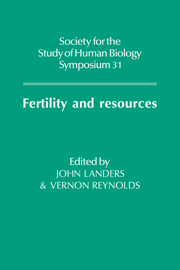Book contents
- Frontmatter
- Contents
- List of contributors
- 1 Introduction
- 2 Environmental and social determinants of fecundity in primates
- 3 Biological aspects of fertility among Third World populations
- 4 A preliminary report on fertility and socio-economic changes in two Papua New Guinea communities
- 5 The cultural context of fertility transition in immigrant Mennonites
- 6 Inter-relationships between consanguinity, religion and fertility in Karnataka, South India
- 7 Resources and the fertility transition in the countryside of England and Wales
- 8 Fertility decline and birth spacing among London Quakers
- 9 Population growth, innovation and resource exploitation
- 10 Fertility decline in developing countries: the roles of economic modernization, culture and Government interventions
- 11 Understanding recent fertility trends in the Third World
- 12 Monogamy, landed property and demographic regimes in pre-industrial Europe: regional contrasts and temporal stabilities
- Index
8 - Fertility decline and birth spacing among London Quakers
Published online by Cambridge University Press: 13 March 2010
- Frontmatter
- Contents
- List of contributors
- 1 Introduction
- 2 Environmental and social determinants of fecundity in primates
- 3 Biological aspects of fertility among Third World populations
- 4 A preliminary report on fertility and socio-economic changes in two Papua New Guinea communities
- 5 The cultural context of fertility transition in immigrant Mennonites
- 6 Inter-relationships between consanguinity, religion and fertility in Karnataka, South India
- 7 Resources and the fertility transition in the countryside of England and Wales
- 8 Fertility decline and birth spacing among London Quakers
- 9 Population growth, innovation and resource exploitation
- 10 Fertility decline in developing countries: the roles of economic modernization, culture and Government interventions
- 11 Understanding recent fertility trends in the Third World
- 12 Monogamy, landed property and demographic regimes in pre-industrial Europe: regional contrasts and temporal stabilities
- Index
Summary
The decline in the marital fertility levels of European populations from the later nineteenth century1 has long been recognized as a landmark in the demographic evolution of the continent, and has been made the subject of a correspondingly detailed scrutiny. Particular interest has attached to the behaviour of the so-called ‘forerunners’, groups which acted as a kind of demographic vanguard reducing their fertility substantially before that of the population at large (Livi-Bacci, 1986). Research on such groups has revealed that they were predominantly urban and that they were usually ‘bounded’ in some way, that is to say they were clearly distinguished from the surrounding population, whether by their enjoyment of a shared sociolegal privilege or by their membership of a minority religion.
In this context the experience of London's Quakers is of particular interest, for in 1861, on the eve of the national fertility decline, the registration districts with the lowest marital fertility were all to be found in the capital (Woods & Smith, 1983) whilst in North America Quakers were apparently one of the first groups to reduce their fertility substantially. In a study of 276 reconstituted families from the middle colonies, Wells (1971) found signs of this among women born 1731–55 and it had become general among the cohort born 1756–85. A recent study by Byers (1982) has also demonstrated the existence of family limitation in Quaker dominated Nantucket from the middle of the eighteenth century.
The present study is based on a family reconstitution of two of London's six ‘Monthly Meetings’ of Quakers, from which it was possible to obtain age-specific fertility and mortality rates, together with data on age at marriage.
- Type
- Chapter
- Information
- Fertility and Resources , pp. 92 - 117Publisher: Cambridge University PressPrint publication year: 1990
- 6
- Cited by

